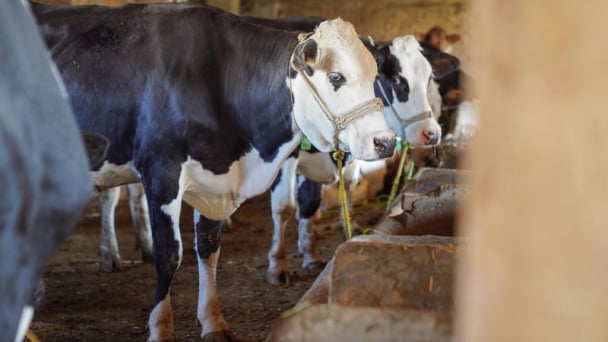May 16, 2025 | 22:00 GMT +7
May 16, 2025 | 22:00 GMT +7
Hotline: 0913.378.918
May 16, 2025 | 22:00 GMT +7
Hotline: 0913.378.918

Powdery mildew, shown here on a barley leaf, stunts the growth of wheat and other crops. Photo: NIGEL CATTLIN
Powdery mildew certainly sounds unappealing, but for wheat farmers the fungus can mean a serious hit to the pocketbook. It infects crops, yellowing leaves and stunting growth. In countries where the blight is common, like China, the microbe can destroy up to 40% of a field, making it one of the most damaging and costly pathogens for wheat farmers.
Now, researchers have developed a gene-edited wheat that’s impervious to the fungus, without stunting the grain’s growth. The approach might work in other crops such as strawberries and cucumbers as well, the team says.
If the yields are confirmed by further research, “this really could be a game changer” for wheat breeders, says plant biologist Beat Keller of the University of Zurich, who was not involved with the work.
“Advances like this are highly needed,” adds plant pathologist Peter van Esse of the Sainsbury Laboratory, who was also not involved. Reducing chemical use is good for the environment, he says, and disease resistant plants are especially helpful for farmers in the developing world who might not have access to pesticides.
Some plants can naturally resist powdery mildew. During expeditions in the 1940s to Ethiopia, scientists discovered local types of barley that were unaffected by the fungus. But these plants, and subsequent versions created by plant breeders, grew poorly and did not yield enough grain. With sustained effort, breeders by the 1980s had managed to create types of barley that could both resist the fungus fairly well and grow vigorously enough to appeal to farmers.
These types of improved barley have been a remarkable success. Unlike many types of disease resistance in plants, which pathogens eventually evolve ways to overcome, the protection from powdery mildew in these varieties has lasted for decades. That’s because of a gene, called MLO, that when mutated somehow prevents the fungus from infecting the barley, apparently in part by quickly thickening cell walls when spores try to penetrate and having other nearby cells self-destruct.
Wheat breeders have not been able to replicate the accomplishment. In wheat, mutations in MLO lead to stunted plants that tend to yield up to 5% less grain than typical plants, an unacceptable shortcoming. Farmers are reluctant to adopt even slightly lower yielding crops, especially if fungicides can kill pathogens.
Several years ago, Gao Caixia, a plant scientist at the Institute of Genetics and Developmental Biology of the Chinese Academy of Sciences, and her colleagues began to study genes involved in yield and disease resistance in wheat. Using gene-editing methods including CRISPR, they created the same protective mutation in the six copies of MLO genes in wheat.
These methods allow researchers to make very targeted changes to a genome. Often these changes could be accomplished with traditional breeding, but over many years instead of months. Another appeal of gene editing is that government regulators in several countries have recently made it easier for researchers and companies to study and commercialize plants made this way, whereas another method of engineering new traits into plants—transferring one species’ DNA into another—often requires extensive testing and lengthy reviews before approval.
Gao’s gene-edited plants resisted infection by powdery mildew, as expected, but to her surprise a single plant also grew just as well as unmodified control plants in greenhouse experiments. “I was sure that we had discovered something amazing,” Gao recalls.
Other researchers say the greenhouse experiments and laboratory data look promising. “I think this is credible,” says Ralph Panstruga, a plant molecular biologist at RWTH Aachen University. “It’s a good starting point.”
The team also compared growth of the gene-edited wheat in limited field trials. The modified plants grew just as tall as other wheat. And when the researchers counted the kernels of grain on each of about 30 plants from the plots, there was no statistically significant difference, they report today in Nature.
Keller cautions that wheat yield cannot be reliably determined by measuring individual plants, but only by harvesting plots that are at least several square meters. “A wheat breeder would say, ‘very nice, but now you have to show it on the plot level.’”
Digging deeper into the genome of the modified plants, Gao and colleagues showed the editing had accidentally removed not only part of an MLO gene, but also a large stretch of DNA on one chromosome. This resulted in a nearby gene called TMT3 becoming more active, and this is what somehow keeps the plant growth normal. The gene codes for a protein involved in transporting sugar molecules, but how it overcomes the yield loss caused by MLO mutations remains a mystery, Gao says. “I remain excited about this surprising finding.”
TMT3 is found in many other plant species. Gao and her colleagues want to try to gene edit strawberries, peppers, and cucumbers, which are also very vulnerable to powdery mildew. Meanwhile, they have gene edited four varieties of wheat that are favored by Chinese farmers, and their yield will be tested with larger field trials.
Before any gene-edited wheat can be sold to farmers in China, the new strains would need to be approved by the agriculture ministry. Gao is optimistic: The ministry’s new guidelines for approving gene-edited crops, she says, provide “a clear path forward” to commercialization.
(Science.org)

(VAN) Fourth most important food crop in peril as Latin America and Caribbean suffer from slow-onset climate disaster.

(VAN) Shifting market dynamics and the noise around new legislation has propelled Trouw Nutrition’s research around early life nutrition in poultry. Today, it continues to be a key area of research.

(VAN) India is concerned about its food security and the livelihoods of its farmers if more US food imports are allowed.

(VAN) FAO's Director-General emphasises the need to work together to transform agrifood systems.

(VAN) Europe is facing its worst outbreak of foot-and-mouth since the start of the century.

(VAN) The central authorities, in early April, released a 10-year plan for rural vitalization.

(VAN) Viterra marked a significant milestone in its carbon measurement program in Argentina, called Ígaris, reaching 1 million soybean hectares measured.